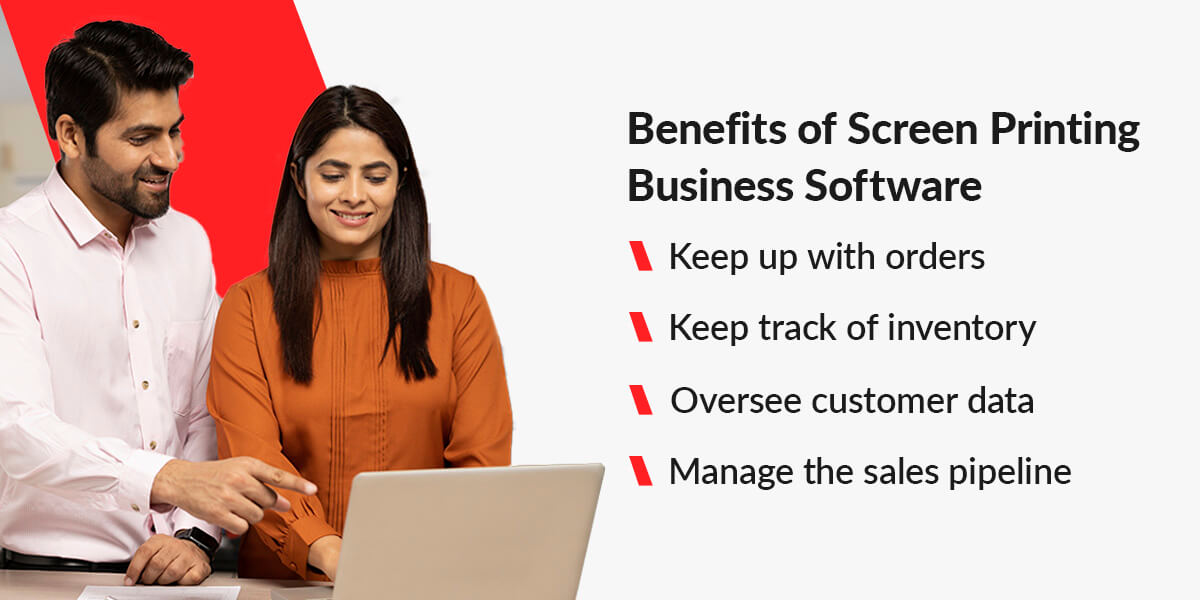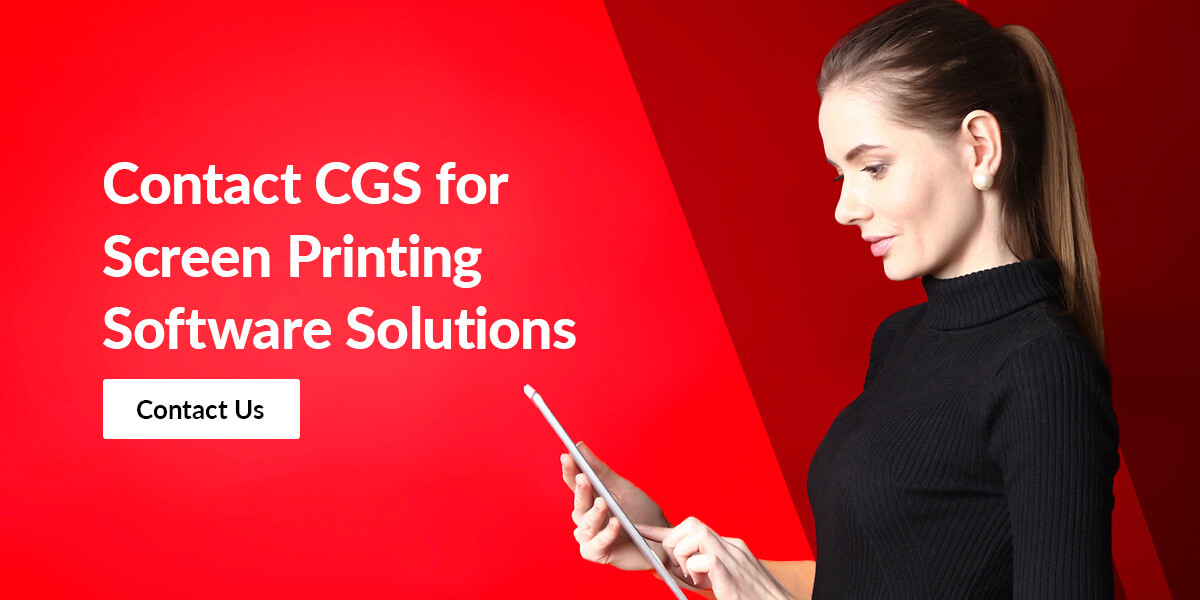Daniella Ambrogi is Senior Global Marketing Director for CGS's Application Services division, which offers BlueCherry® software and services to 500+ fashion, footwear, consumer goods and retail companies worldwide. Ambrogi offers 20+ years of experience in the fashion and retail business; she understands a brand's complex needs in an ever-changing marketplace.
Topics
Choosing the Right Screen-Printing Management Software

Screen-printing is the process of transferring a design onto a screen using one color at a time. It can create exciting, memorable graphics on items like bags or shirts.
Screen-printing design software can help your company improve its business processes, track customer orders, and streamline organizational efforts. Explore the challenges of screen printing, including bleeding images, inconsistent patterns, or detail loss. Learn what screen printing management software features fit your needs, the functions to consider and the benefits of using reliable solutions.
You can find the best platform for your business needs by exploring the various management tools. Whether you're a startup company or a large business that has become popular in the community, you'll need this valuable information.
Challenges of Screen-Printing
Learning the common pain points of screen printing can help you decide what software best fits your needs. Here are several hurdles your company might experience.
1. Bleeding Images
The screen-printing process is simple, relying on stencils to create an image or logo on various materials. However, applying the stencils and colors correctly can make or break the image. Stenciling techniques include using masking tape, painting with screen blockers, or using light-sensitive emulsion. All methods apply colors with multiple layers and separate stencils, though bleeding can happen. The image could be blurry if you haven't adequately prepared your stencils or designed a consistent pattern that prevents bleeding.
2. Detail Loss
Loss of detail may occur when you have a high number of repeat items. If your stencils aren't working, your design's details may become blurry or discolored.
3. Ink Viscosity
Off-ink viscosity may create less-than-desirable results for your projects. Short ink drops look like blobs, while long ink drops become skinny and stringy. While short ink drops are ideal, finding the correct formula for your ink each time can be challenging.
4. Off Contact
Color density maintenance can be complex. It is often the result of uneven platen levels, which cause off-contact distance and a shift in visible hues.
5. Fibrillation
Fibrillation is typical on light-colored shirts, bags, and apparel. Prints with transparent inks for white shirts may often produce this effect. Washing the ink after making the clothing may result in the breakage of unprinted fibers, diminishing the image's appearance by causing it to dull or frost. A consistent production strategy can help lessen these effects.

6. Screen Tension
Screen tension occurs when the squeegee passes over your mesh and does not snap off. It can leave behind a dull or frosted print. Proper screen tension allows for crispness and clear images without any rippling of the substrate or smearing of edges, blurred ink or shifted surfaces.
7. Substrate Movement
Sometimes the substrate shifts during printing, causing unappealing blurred edges, distorted images, and reduced quality. To avoid this issue, ensure your printing process includes consistent checks for loose pallets.
8. Stencil Issues
Another area for improvement in the printing process is stencil problems. The issue may occur when inks need to be print-ready, leading to bad mixes, too many additives or over-diluted paints.
9. Sticking Image
Some designs may produce blurred edges due to ink-related issues, equipment problems and setup process disruption. A sticking image can also result from stencil issues, improperly exposed emulsion, weak stencil edges during printing and washing or other production problems. A sticking image causes strangely blurred edges and makes the screen visible on the edges of your print.
10. Quick Drying
Quick-drying paint occurs when the ink immediately dries after you print the design, which can reduce the quality. This phenomenon may happen if you add too much ink to the print medium or leave the screen to dry between prints.
11. Overstaining
Overstaining is another frequent obstacle in the screen-printing process, and it can result from overmixed ink with the print medium. Many companies try to reduce overstaining by flooding screens, applying disinfectant spray, and rinsing the screen after use.
12. Opacity
Opacity is a regular challenge screen printing software may address. This issue occurs when substrate colors show through your print, making images look dull. The problem worsens on dark fabrics, which require covering with layers of color that are thick enough to be durable without causing stiffness.
13. Improper Curing
Curing is a chemical process that helps the ink dry properly and stick to the material, and it's integral in screen printing. However, improper curing can result in visible cracks in ink on fabric after washing. If you rush through this step, your designs may become cracked, warped, or ripped, reducing customer satisfaction.
What Is Screen-Printing Business Software?
So, what is screen-printing shop management software, and how can it help your business?
Technology can be invaluable for artists who need consistent, accurate prints. Screen-printing software can help you manage your processes and create compatible designs every time. You can generate professional-quality images while ensuring separate colors, efficient designs and exciting illustrations.
Functionalities of Screen-Printing Management Software
Understanding the essential functions of software for screen-printing can help you find the best program for your business needs. Screen print software offers several features to help you run your shop, including applications for financing, sales, and orders.
Features may include the following.
- Quotes from customers: See and approve customer quotes from all areas of your business.
- Artwork approval: Approve artwork for creation and production. You can ensure all artwork fits your specs for product consistency.
- Production integration: Integrate production management tools into your current process. Use calendars, scheduling, and financing software applications to fit your needs.
- Payments and information tracking: Track all charges, bills, fees, and customer orders. You can keep customer information in one central database, which makes customer service fast and easy.
- Purchase orders: Look at all your purchase orders in one place. You can explore what the customer ordered and how many shirts they need and integrate helpful information like customer names, birth dates, card numbers, past orders and more.
- Sales reports: Screen printing management software allows for a central sales report system.
Benefits of Screen-Printing Business Software
Here are some advantages of using screen printing business software.

- Keep up with orders: It can be a struggle to manage customer orders and keep up with a large influx of requests. Screen printing business software runs your e-commerce store to help you create a valuable online space, track customer orders, and oversee payments.
- Keep track of inventory: Other businesses may quickly lose track of their inventory and production schedules when they receive multiple orders. Screen printing business software helps you simplify your company's production schedules, track inventory and automate workflows.
- Oversee customer data: Dealing with customer orders and information may be complex, but screen-printing business software helps you streamline your data through tracking, order history and contact information retention.
- Manage the sales pipeline: Take care of your sales pipeline using screen printing business software. You can use tools to track leads, create reliable quotes and convert customers into leads.
What to Consider When Choosing Screen-Printing Production Software
Screen-printing business, production, scheduling and shop software offer many valuable services to ensure your business succeeds and provides consistent, appealing fashion for your customers. Here are a few things to consider when choosing screen printing software.
1. Features
Consider what features best fit your business needs. Some software includes customer portals, stock search abilities, calendars, interactive job boards, pricing management and online payments. What parts of the software you are exploring appeal to your company?
For example, some companies may benefit from a helpful calendar application where they can view all customer orders and set deadlines for order completion or graphic design creations. Others may enjoy interactive job boards, which help employees learn about their duties and explore their daily or weekly tasks. All these processes can help make your organization smooth and seamless.
2. Limitations
Consider any limitations of the software you're considering. Can it handle a steady flow of incoming product orders and management? Or is it more for smaller startup businesses that might only receive a trickle of orders?
While some startups may enjoy the simplicity of straightforward software, others looking to organize their business processes will benefit from a platform that can support a higher volume. Be sure to weigh the potential disadvantages of software before investing in it any further.
3. Costs
Explore how much the software management integration may cost. Will it fit within your budget and satisfy your needs? Some companies offer free versions of their software for those on a budget, though spending a little more money to ensure you have full features can be a worthwhile investment.
Free software is perfect for startups on a tight budget that don't have a large influx of orders yet. However, if you are a large apparel business that often receives hundreds or thousands of orders a month, you'll need to spend a little extra on software that can adequately handle your needs.
4. Reviews
Look for reviews and testimonials to see what current and past clients think of the tools. Are they reliable and helpful? Do they support clients when issues arise, or is it hard to get in touch with them?
Some platforms may look like they can solve all your headaches, but their client reviews say otherwise. Exploring the perspectives of business owners in your niche can also be worthwhile. If the software has overall positive reviews from genuine clients, you can strongly consider them as an option.
5. Support
Explore how often the software company can support your problems and find fast solutions for your issues. Ask yourself whether the tool is user-friendly or tends to glitch when receiving an influx of orders.
Software support is essential when running a screen-printing business. Without help from technicians, IT team members or coding experts who designed the system, your company may be high and dry during technical issues, online errors, or other system problems. You'll need a team who can quickly address any problems and protect your company's bottom line.
6. Import Abilities
Does the software allow for imported features and extra abilities? Some apparel companies may need features that apply to their specific and unique processes. Software that can easily integrate with imported applications is appealing to many businesses.
For example, if you'd like to include calendar features, task bars or other unique forms of organization, you'll want to find software that supports those add-ons. Ask yourself and your team members what innovations and extra abilities might be right for your business. What can you live without, and what do you need to succeed in the screen printing business?
Implementing Screen-Printing Management Software
Implementing apparel decorating software for screen printers can ensure your business processes run smoothly. You must integrate your screen-printing software with your current processes to improve aspects like scheduling, production, completion and sales.
Software solutions from companies like CGS offer reliable apparel enterprise resource planning and product life cycle management. You can compete with other businesses and succeed in your industry through attractive clothing designs and optimal business management strategies.
CGS' BlueCherry solutions help top brands and businesses optimize their current operations, overcome challenges and use real-time visibility to control their supply chain. Integrated SaaS helps fashion, apparel and footwear companies improve decision-making through helpful strategies and streamlines product delivery.

Contact CGS for Screen Printing Software Solutions
CGS provides supply chain solutions to customers worldwide. The BlueCherry Enterprise Suite includes helpful features like enterprise resource planning (ERP), B2B e-commerce, shop floor control and product lifecycle management ( PLM). The robust set of valuable tools helps drive your business to success and streamlines your processes. We address needs like product development, planning, core management, manufacturing, logistics, finances and sales functions. Contact us today to speak to a representative or explore our services online.
Daniella Ambrogi is Senior Global Marketing Director for CGS's Application Services division, which offers BlueCherry® software and services to 500+ fashion, footwear, consumer goods and retail companies worldwide. Ambrogi offers 20+ years of experience in the fashion and retail business; she understands a brand's complex needs in an ever-changing marketplace.

